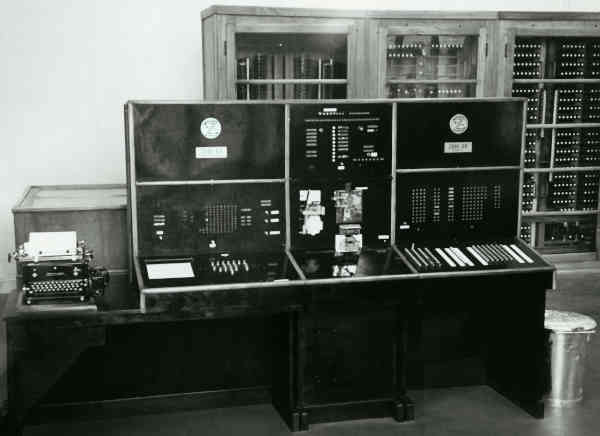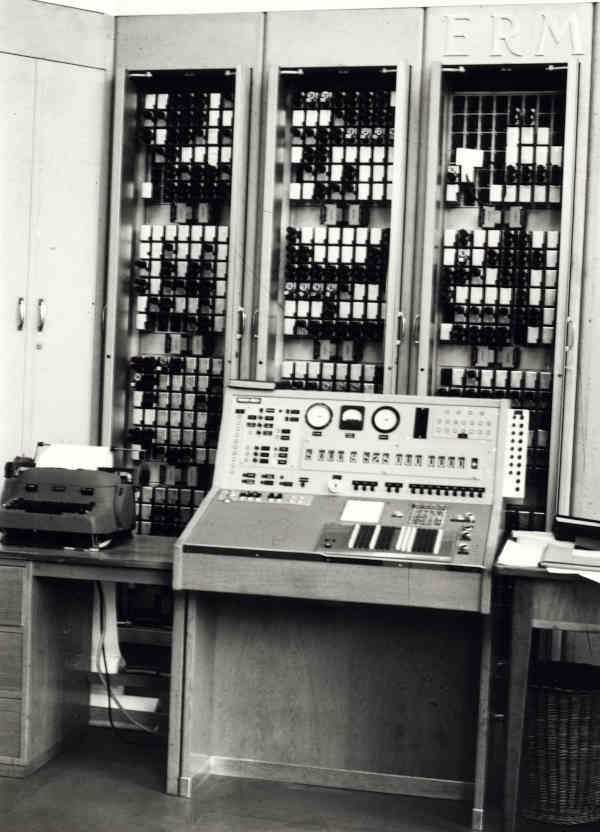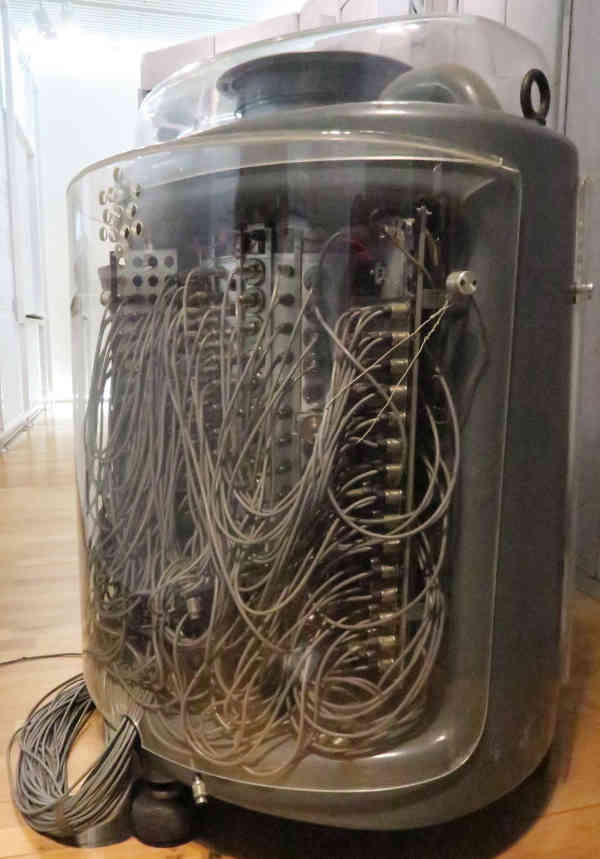
Computer science in Switzerland began in 1948 with the founding of the Institute for Applied Mathematics at ETH Zurich. Eduard Stiefel was the director, with assistants Heinz Rutishauser (chief mathematician) and Ambros Speiser (chief engineer), see Figs. 1-3.
In 1950, ETH Zurich was the first and only university in continental Europe with a functioning punched-tape controlled computer, the Zuse Z4, see Fig. 4.
In Sweden, the plugboard-controlled Bark relay computer was put into operation in 1950. The Swiss Polytechnic used the leased mechanical relay computer from 1950 to 1955. In 1951, the trio published a fundamental work on computer construction. One year later ,Rutishauser’s postdoctoral thesis on automatic programming (program production with the help of the computer) was published. He was one of the fathers of the Algol programming language.
In 1956, the self-built Ermeth electronic vacuum tube computer was operational, see Fig. 5.
Despite these good conditions, no IT industry emerged in Switzerland in the 1950s. This was often puzzling. What were the reasons for this?
|
|
|
|
Figs. 1-3: From left, Eduard Stiefel (head of the institute), Heinz Rutishauser (chief mathematician), and Ambros Speiser (chief engineer).
Credit: ETH Library, Zurich, image archive.
Bern Hasler AG wanted to market Ermeth worldwide
The company Hasler AG, Bern (today Ascom), was involved in the construction of the electronic computer, and also provided financial support. As has only been known for a few years, Hasler wanted to market the expensive machine worldwide. To this end, it concluded a license agreement with ETH in 1954 for the magnetic storage drum, which it had not helped to construct, see Fig. 6.
The development of the drum memory device had caused great difficulties. However, Speiser left ETH at the end of 1955, before the completion of Ermeth. He surprisingly became the director of the newly founded IBM Research unit near Zurich. This thwarted Hasler’s plans.
At this time, two other U.S. research laboratories were coming to Switzerland, in addition to the blue giant: Radio Corporation of America (RCA, Zurich) and Battelle (Geneva). IBM recruited specialists with high salaries. Speiser’s departure for the competition led to discord between Hasler and ETH. On the instructions of the president of the Swiss School Board, he therefore had to make an appointment with the General Director of the Bern company. Hasler lost interest not only in the reproduction of the magnetic storage drum, but also in the entire computer. This background has only recently become known, thanks to finds in the ETH university archives. A detailed account of the dispute between Speiser, Hasler, and ETH can be found in “Milestones in Analog and Digital Computing, volume 2.”
Fig. 4: The Zuse Z4 relay computer (1950).
Credit: ETH Library, Zurich, image archive.
Fig. 5: Ermeth vacuum tube computer (1956)
Credit: ETH Library, Zurich, image archive.
Fig. 6: Magnetic drum memory of the Ermeth (1957).
Credit: Radomir Novotny, electrosuisse.
Both machines have been preserved. The Z4 is now located in the Deutsches Museum in Munich, while the Ermeth and its drum memory are on view in the Museum für Kommunikation in Bern.
Later attempts also failed
Even later, it was not possible to build Swiss computers in large numbers. This is true, e.g., of the Cora transistor computer (1963) made by Contraves, the Lilith workstation (1982) of Niklaus Wirth, and the Gigabooster super computer (1994) by Anton Gunzinger.
Today, in addition to Logitech, there are numerous research centers in Switzerland run by Internet giants such as Apple, Facebook, Google, and Microsoft.
References
Bruderer, H.: Meilensteine der Rechentechnik, De Gruyter, Berlin/Boston, 2nd edition 2018, 2 volumes, 1600 pages, https://www.degruyter.com/view/product/480555 and https://www.degruyter.com/view/product/503373
Bruderer, H.: Milestones in Analog and Digital Computing, Springer Nature Switzerland AG, Cham, 3rd edition 2020, 2 volumes, 2000 pages, https://www.springer.com/de/book/9783030409739
Bruderer, H.: Sternstunden der Rechentechnik, 3rd edition 2020, 2 volumes, 2000 pages
Rutishauser, H.: Automatische Rechenplanfertigung bei programmgesteuerten Rechenmaschinen, Birkhäuser Verlag, Basel 1952, 45 pages
Herbert Bruderer is a retired lecturer in didactics of computer science at ETH Zürich. More recently, he has been an historian of technology. bruderer@retired.ethz.ch, herbert.bruderer@bluewin.






Join the Discussion (0)
Become a Member or Sign In to Post a Comment